Sunday, August 10, 2008
New Blog Destination - LeapComp.com
When I started this blog in January, I never expected to gain such a large readership so quickly. It was now time to move my blog to a more permanent destination. I am in the process of improving the new home for this blog at: leapcomp.com.
It may take a few more days to get it to work perfectly, and in the meantime I will appreciate your feedback. I migrated all the content, so please update your bookmarks and Feed Readers to point to this new location.
Many thanks,
Julien
Tuesday, July 29, 2008
Offshoring SPM - Communication Challenges
 One of the most important challenges in leverage an offshore team for an IT implementation is to communicate effectively. If this is not taken seriously, all the efforts surrounding making the offshore strategy successful could be wasted.
One of the most important challenges in leverage an offshore team for an IT implementation is to communicate effectively. If this is not taken seriously, all the efforts surrounding making the offshore strategy successful could be wasted.Communication can be difficult because:
The offshore team is often in a different time zone. Meetings are often very early in the morning, or very late at night (often both).
- Meetings are usually virtual - often onshore and offshore team members never meet.
- The onshore and offshore team don't always share the same first language. Even in a situation where they share the same first language, accents can be a problem. (Although it can also be a problem between onshore resources). I think people get used to by French-Canadian accent fairly quickly, but it took me a long time to get use to the Indian accent. Expressions also vary from country to country.
- There can be cultural differences leading in communication failure.
Erran Carmel and Paul Tjia wrote a great book called "Offshoring Information Technology - Sourcing and Outsourcing to a Global Workforce" in which they list examples of such communication failures with Indian offshore teams. Among their observations, they say that Indians are less likely to engage in small talk than most of their Western counterparts and that they tend to be too optimistic about times and schedules (referred to as the "Indian factor"). Indians are also reluctant to say "no"; they may say "yes" even when they mean "no" to avoid having to give bad news.
Their book also lists many expressions used in English which can be interpreted in a bad way by an offshore team. For example, when an English speaker says "Not bad", he means the work is good; the offshore resource could interpret that as the work being of poor quality. Another example is when an English speaker says "Interesting!", it can mean he or she does not agree or believe what the other person is saying; this could be understood as "they are impressed" by the offshore resource.
Improving Communication
- Avoid slang, idioms and acronyms, and speak slowly. Ensure your message is well understood
- When giving a task, ask probing question to ensure the task is well understand.
- Keep written communication short
- "Offshoring Information Technology" mentions six "R" rules: Repeat, Reduce, Rephrase, Reiterate, Review and Recap.
- Have regular meetings (usually daily)
- Use collaborative tools such as Wiki's when possible
- Be patient - you may have problems understanding them and vice-versa, but treating each other with respect is they key to develop a solid working relationship.
- Read more about the cultural differences with the country in which the offshore team is located.
- If the project is big enough and the offshore contribution significant enough, it may be worth it to meet the offshore team in person. This should create stronger bonds between the onshore and offshore team.
- If most of the meetings are held over the phone (video conferencing not available), sharing pictures of the team members can also help out in creating bonds.
Monday, July 28, 2008
Makana Motivator for Free!
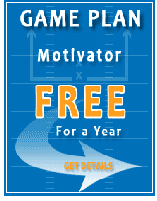 I talked about Makana Solutions' product - Motivator - before. Makana offers a solution to build really good compensation plans and help you out in the process every step of the way.
I talked about Makana Solutions' product - Motivator - before. Makana offers a solution to build really good compensation plans and help you out in the process every step of the way.Game Plan
Makana just launched a new program called "Game Plan". Game Plan is a free program to help out with your 2009 Sales Compensation planning. It offers a free year's subscription to Makana Motivator and strategic advice with sales compensation experts.
The catch? You have to take a training in July or August to receive your free one year subscription. That probably doesn't sound too bad, so there is no reason why you shouldn't check it out.
Note: Makana didn't ask me to promote this "deal". I don't usually promote any Sales Performance solution, but... it's free!
Webinar Galore - 2 SPM Webinars Tomorrow
Callidus 7/29 @ 9A CST - Best Practices from Accenture - Align producer and advisor behavior, maximize mindshare - and effectively manage compensation
https://callidussoftware.webex.com/callidussoftware/onstage/g.php?d=570992696&t=a
Learn about insurance industry best practices from Jon Walheim - Accenture Partner - North America Insurance Marketing, Sales, and Service Lead. You’ll learn about key trends in the insurance industry, challenges that organizations are facing, and what insurance leaders are doing to gain competitive advantage.
Xactly 7/29 @ noon CST - The Business Case for On-Demand Sales Performance Management Analytics
https://www1.gotomeeting.com/register/415893690
In this Webinar, Xactly’s Karen Steele and THINKStrategies’ Jeff Kaplan will discuss how post-sales analytics can provide new and strategic insight into an organization’s selling patterns, commission spend, product performance, sales rep and team performance, and sales plan effectiveness. They will examine how post-sales data – traditionally scattered across a variety of disparate systems including ERP, HR, and Payroll – can be now be integrated and analyzed with an eye towards enhancing business strategies, changing sales rep behaviors, and super-charging sales organizations.
Saturday, July 26, 2008
Topgrading for Sales Book Review
The Topgrading team sent me a copy of their newest book “Topgrading for Sales” to review. The book focuses on recruitment, an area in which I have very little experience. However, I think the book is relevant to this blog; incentive compensation is one way to increase your workforce performance, but at the root, it is important to hire top sales representatives.
When I first picked up the book, my first thought was - wow, this book is only 57 pages, 113 pages counting the appendix. However, when I opened the book I quickly realize that while it is small in size, it is heavy in content.
Topgrading for Sales promotes the Topgrading philosophy, to only hire “A Players” A definition of top performers and an explanation of the general concept is provided in the first chapter, and the following chapters detail methods to interview, hire and coach top sales reps. The appendix includes practical templates to topgrade your sales force.
Here is a quick summary of the proposed steps to increase hiring success:
- Construct a sales rep score card to know which skills and attributes are required (what needs to be done)
- Analyse your sales team and determine what your top performers have in common, as well as what your bottom performers have in common.
- Create a list of prospects
- Ask good phone screening questions (many good examples are provided in the book)
- Screen finalist candidates rigorously
- Perform a reference check after the interview and contact all supervisors in the past 10 years
- Coach your sales reps regularly
This book is extremely practical. It provides many great tools and ideas to hire top sales representatives and the general concept can be taken beyond the “sales world”.
However if you don’t have prior experience in recruitment, other books will be required to build a solid foundation in some of the many areas touched by this book such as interviewing and coaching.
Thursday, July 24, 2008
New web forum for the EIM Community - Get your Answers Now!
 Today I came across a web forum called "Ask Jon!" by OpenSymmetry. It's a great knowledge exchange platform where anyone can submit questions and answers.
Today I came across a web forum called "Ask Jon!" by OpenSymmetry. It's a great knowledge exchange platform where anyone can submit questions and answers.Most posts are currently related to Callidus TrueComp, but there are new categories to discuss solutions by many other SPM vendors such as nGenera, Oracle, Practique & Merced, Sungard, Varicent, Xactly, etc.
Such forums are only as good as the content being posted, so I encourage everyone to visit and contribute in making this forum a one-stop shop for Sales Performance related information.
Of course my blog is still THE number one source of SPM information, but I may not [always] be able to answer all your questions, about every product on the market.
Don't wait, go have a look and sign-up.
Monday, July 21, 2008
SPM Analytics Webinar Tomorrow, 1PM Central
Remember to join the free Webinar: 5 Best Practices with Analyzing Sales Performance, hosted by OpenSymmetry and presented by Greg Livengood.
When? Tuesday, July 22nd 1pm (Central).
Find out more about the presenter here.
Register here.
Friday, July 18, 2008
Offshore Outsourcing - Humor of the Week

A friend also sent me this funny conversation between a consultant and an offshore resource:
Consultant: So, today is the checkpoint for the designs, status should be on 90% completed, meaning everything’s done and waiting for final review. Are you finished?
Inder: Yes, I put the status on 90% completed
Consultant: Ok, let’s have a quick look at the document. Well… the document is basically empty? How can you put it on 90% completed?
Inder: Yes, document is empty – but it’s all in my head!
In Summary:
- The communication infrastructure in some countries can be unreliable.
- Risks associated to offshoring should be identified early.
- Expectations need to be set and communicated clearly.
Wednesday, July 16, 2008
Compensation Architect: The New Blog on the Block
 I mentioned Santorini Consulting a few times in previous posts and they just told me they had started their own blog called "Compensation Architect – Your guide to designing, implementing and managing effective compensation solutions".
I mentioned Santorini Consulting a few times in previous posts and they just told me they had started their own blog called "Compensation Architect – Your guide to designing, implementing and managing effective compensation solutions".So far, David Kelly, a fellow compensation management expert, is the main contributor. Sheryl Friesz, Founder and VP of Partnerships, and Brian Silverman, President and CEO of Santorini Consulting, are also planning to contribute their perspective on related topics. Each have acquired years of experience working at Callidus Software before joining Santorini.
Their 3 first posts which have been published at a frequency I hope they will be able to maintain, provide insightful information about sales compensation, policies versus procedures and the difference between reports, queries, feeds and analytics.
Hopefully, over the next few weeks we'll see some synergy between our blogs, and rather than creating redundant entries, we will each be able to provide fresh perspectives and information to our readers. Even in a field as specialized as incentive compensation, there should always be a place for blogs from product vendors, consulting companies and especially from independent guys.
Go on, take a few minutes for a visit.
Tuesday, July 15, 2008
Offshoring Sales Performance Management Implementation Components
 Based on my experience and on common sense, there are some project components which are easier to offshore than others.
Based on my experience and on common sense, there are some project components which are easier to offshore than others.- ETL: A large project will use an Extract, Transfer and Load (ETL) tool to move data where it can be used by the SPM solution. With proper access, an offshore team can make a significant contribution to this process.
- Configuration Management: An implementation is usually carried in different environments; development, various testing envionments, and production. Moving the latest files from one environment to the next can be very time consuming, and often can't be performed while a team works in the environment.
- Reference Data: Loading all the reference data including participants, titles, positions, relationships, territories, etc are activities which will not impact the building of plans, until required for testing.
- Quotas, rate tables and lookup tables: Creating and updating these objects can be a very time consuming activity.
- Formulas and rules: Sometimes, several formulas and rules which are almost identical to each other are required. Not all SPM solutions have an easy "clone" feature, making this activity very tedious.
- Processing: Also called pipeline in Callidus TrueComp, with a large number of participants and of transaction (in late testing phases), processing can take up to several hours. It can be very nice for the onshore team to work on the implementation during the day and come back the next morning to find the results ready and analysis of issues that occured.
- Testing: Testing can be a tedious job. As I discussed before, test scripts should exist which will be executed again and again... and again. Some of the first testing phases such as unit testing and system testing can be almost entirely offshored, but later phases such as integration testing and user acceptance testing are often kept onshore to be able to better monitor quality.
Does anyone have other examples of SPM components which can be offshored easily?
Friday, July 11, 2008
Incentive Compensation Industry News
- Subscription and support revenues for the second quarter are expected to be approximately $10.0 million, an increase of 68% over the second quarter of 2007.
- Callidus On-Demand (subscription) gross margins for the second quarter are expected to be within the range of 45 to 50%, up from 22% in Q1 2008.
WageWorks Selects Centive Compel(R) to Automate Sales Compensation Management
Centive, the leader in on-demandsolutions for sales compensation and sales performance management, todayannounced that WageWorks, the leading provider of tax-advantaged benefitsprograms, has selected Centive Compel to automate sales compensation and drivesales performance. Here is another related article.
Xactly Named World's Best New Company by 2008 International Business Awards(SM)
Xactly Corporation took home theprestigious International Stevie(R) Award in The 2008 International BusinessAwards.
Thursday, July 10, 2008
Popularity Burst
 I'm not sure what is happening to my search engine ranking on Google, but it has been climbing very quickly over the past few weeks! Here are a few examples as of this afternoon:
I'm not sure what is happening to my search engine ranking on Google, but it has been climbing very quickly over the past few weeks! Here are a few examples as of this afternoon:- Incentive Compensation: 10 (1st page!)
- Sales Performance: 17
- Enterprise Incentive Management: 20
- Incentive On-Demand: 7
- Incentive Offshoring: 2
- Incentive Compensation Implementation: 1 (woohoo!)
And that's not including all the vendor-specific keywords where I'm also ranking very well.
Thanks to everyone who kindly link to this blog. Your help in making it more visible is very appreciated. Please keep the comments, topic ideas and questions coming.
Julien
Upcoming Sales Performance Analytics Webinar, July 22nd 1pm Central
There is a very promising webinar coming up, hosted by OpenSymmetry and presented by Greg Livengood.
I particularly wanted to promote this event because I worked with Greg for several months on an Accenture project, and I know that when it comes to Sales Performance Analytics, he REALLY knows what he is talking about. Expect a very insightful presentation by a friendly, dynamic and easy-going individual who built a world-class reputation as a sales performance analytics leader and pioneer.
Event Description:
With the economy in a downward slope, sales leaders more than ever need 'Sales Performance Analytics' and efficient ways to proactively identify potential problems and opportunities.
Most companies have the information they need to improve sales performance, however, many sales managers are challenged with accessing and correctly interpreting the data.
Greg Livengood, Senior Business Analyst with Livengood Consulting Group, will discuss how to leverage the 5 best practices in sales performance analytics that can boost your sales force performance.
• Visualize Sales Performance
• Develop Corporate Alignment
• Simplicity
• Build a Self-Sufficient Solution
• Engagement at the Executive Level
Click here to register.
Tuesday, July 8, 2008
ICM Implementation Offshoring Pros and Cons
 Projects can be partially or completely outsourced. The outsourcing can be done partially or entirely offshore. The most common scenario I usually encounter is when a company outsources a project to a consulting company. The consulting team usually works on-site, and often have several resources located offshore. There seems to be a trend for consultant who used to work on-site, to be allowed to work remotely.
Projects can be partially or completely outsourced. The outsourcing can be done partially or entirely offshore. The most common scenario I usually encounter is when a company outsources a project to a consulting company. The consulting team usually works on-site, and often have several resources located offshore. There seems to be a trend for consultant who used to work on-site, to be allowed to work remotely.Setting aside all ethical and macro-economics discussions about offshoring, here are some of the main pros and cons.
Cost: Savings could be only marginal, especially with rising labor costs in some countries (especially in India)
Quality: This is a challenge for on-site and offshore team alike. Offshore teams are usually very good at achieving very high quality standards. However, quality is still perceived as a higher risk with offshore teams.
Security: Quality is another concern most companies have, especially when dealing with confidential employment information. There are very secure mechanisms to collaborate, even across continents, but security is a topic which requires particular attention.
Key to Success
In my opinion, the key to successfully leveraging an offshore team is in:
- Having a good manager and team leads experienced with offshore projects
- Having A good [formalized] communication strategy, "hand-off" mechanism between onshore and offshore teams and processes in place
- Having a good understanding of which project components can be tackled "at night" by the offshore team and handed to the onshore team "in the morning", and vice-versa.
Sunday, July 6, 2008
Outsourcing and Offshoring your SPM Implementation
 I'm planning to write several articles related to sales performance management outsourcing and offshoring. Let me first define what outsourcing and offshoring means.
I'm planning to write several articles related to sales performance management outsourcing and offshoring. Let me first define what outsourcing and offshoring means.Wednesday, July 2, 2008
Six Disciplines Execution Revolution Book Review
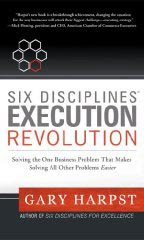 I spend quite a bit of time every week reading books; technical books, business books, compensation books… But over the last few weeks I have mostly been catching up on classics. This is the only “excuse” I have for not blogging about a new book called Six Disciplines Execution Revolution, by Gary Harpst which was released just yesterday.
I spend quite a bit of time every week reading books; technical books, business books, compensation books… But over the last few weeks I have mostly been catching up on classics. This is the only “excuse” I have for not blogging about a new book called Six Disciplines Execution Revolution, by Gary Harpst which was released just yesterday.Gary is the founder and CEO of Six Disciplines, offering small to mid-size companies a business excellence program based on six business disciplines: strategizing, planning, organizing, executing, measuring and learning. Gary’s previous book, Six Disciplines for Excellence, focused on those disciplines and strategy. His latest, Execution Revolution focuses on the biggest business challenge: strategy execution in the real world.
Gary told me how business leaders often try to solve the wrong problem rather than addressing the root cause issues. He said that by fixing the right problem, the solution to every other problem will be more obvious. Without execution, strategy is useless. This book provides a concrete framework to put the plan in action. This is particularly challenging because strategy only relies on a few people for a short period of time every year. On the other hand, execution relies on everyone in an organization, all the time.
Achieving excellence is also tricky. Gary said that by solving current issues, an organization will grow, which will cause even bigger challenges. “Excellence is a journey – not a destination.”
Gary explained to me how business methodology was comparable to IT methodology; you have to be able to repeat a process consistently over the long term to be successful. In my experience, many book in this category read like a text book. Execution Revolution distils concepts, frameworks and real-life examples which can be applied by small businesses.
I was particularly interested by this book because not only does it talk about how a business can achieve excellence, it also focuses a lot on performance management. Throughout the book Gary acknowledges the importance of performance measurement, performance measurement, business intelligence and analytics, and performance management systems.
Overall, this book is straight to the point, well-organized, and as the title suggests, focused on execution. Order it today.
Thursday, June 26, 2008
SPM News - Big News for Callidus, Varicent and OpenSymmetry
 Varicent Software Announces Strategic Partnership with OpenSymmetry
Varicent Software Announces Strategic Partnership with OpenSymmetryVaricent Software, an innovator and provider of the only comprehensive application for sales performance management (SPM), recently announced a strategic partnership with OpenSymmetry, a largest independent consultancy specializing in sales performance management.
Other partners of OpenSymmetry include Actuate, Callidus Software, nGenera, Oracle, Sungard, TerrAlign and Xactly.
Callidus Software Broadens Performance Management Capabilities with Introduction of TrueTarget
The new SaaS-based software module, TrueTarget™, combines SPM and Employee Performance Management (EPM) capabilities to deliver Pervasive Performance Management (PPM) across the entire enterprise. The concept of PPM offers a single, business-wide, pay-for-performance solution for companies.
Pervasive Performance Management goes beyond standard incentive compensation management and includes objectives alignment, goal management, bonus allocation and employee evaluation.
I could be wrong, but as far as I know the only other major vendor currently offering a similar end-to-end solution is SuccessFactors. [Disclaimer: I have not seen Callidus TrueTarget or any of SuccessFactors' solutions yet]
Wednesday, June 25, 2008
Don’t Automate Chaos
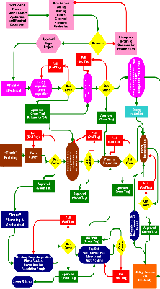 I came across an interesting article by Roy Altman: Avoiding "Gotcha's" - Tips and Techniques that Drive Successful Implementation Projects.
I came across an interesting article by Roy Altman: Avoiding "Gotcha's" - Tips and Techniques that Drive Successful Implementation Projects.If your processes currently result in chaos, and you automate them, you end up with automated chaos.
Tuesday, June 24, 2008
Sales Performance Management Glossary
 There is a lot of very specific terminology used in the world of sales performance management. Different vendors may use different terms, so it is important when starting a project to make sure everybody understands what is what to avoid any confusion.
There is a lot of very specific terminology used in the world of sales performance management. Different vendors may use different terms, so it is important when starting a project to make sure everybody understands what is what to avoid any confusion. Plan: A collection of rules that specify how to compensate the participants assigned to that plan.
Position: Defines a specific, unique job.
Quota: A predetermined sales performance goal, expressed as a percentage, percentage change, in absolute numbers, or in units sold.
Rule: A way to filter and calculate in the form of an "if-then" statement. The "if" contains a Boolean expression that selects objects from the database (for example, which transactions to use). The "then" part contains formulas that calculate and save new values.
SPIF: Acronym that stands for "Sales Promotion Incentive Fund." SPIF is a loose term referring to an on-the-fly addition to the compensation plan used to motivate the sales force in a particular way by providing additional sales credit or payment for certain types of sales.
Territory: A way of defining which transactions a participant should be credited with. It is usually a geographic area, but could also be an industry or a specific set of customers.
Title: Occupational grouping, such as engineers, systems analysts, etc. Titles are used to group similar positions related by job function across the organization.
Transaction: The original sales data, wich includes sub-line data on an order.
Variable: A placeholder in a rule or formula for a fixed value, rate table, or territory.
Monday, June 23, 2008
Stick to a Naming Convention - It's not Rocket Science!
 Wikipedia has one of the best definitions on the net for a "naming convention": A naming convention is a convention for naming things. Awesome!
Wikipedia has one of the best definitions on the net for a "naming convention": A naming convention is a convention for naming things. Awesome!- Make the name descriptive
- Use abbreviations to identify object type
- Begin object name with its object type abbreviation
For example, a credit rule could be called CR_AE_description. Some systems could have a direct credit rule and an indirect credit rule; in such case my abbreviation could be DC and IC instead. In some systems I may want to prefix a formula with F (if all objects can be displayed in the same view), if not, then it would not be necessary to explicitly say that a formula is a formula.
Naming of output is also important: The importance of naming an object may be obvious, but in the case of rules, the output of such rule should also be named carefully. A result name that makes sense can often by "Rule name _ result" or something similar.
Getting Started...
It is important to define a naming strategy early on in the project - before any detailed / technical design documents are created. The strategy should be illustrated on one page to enable the implementers to quickly see how to name the different objects. This "page" should be distributed to everyone involved in the implementation and be given to new joiners as well.
The first steps in defining the naming strategy is to find out if the application being used has a set of best naming practices or standards. In the case of an upgrade, it is important to stick to previously used naming strategy.
Happy Naming!Monday, June 16, 2008
Incentive Compensation News
Thanks HR Wench :-)
Merced Systems, Inc. Acquires Practique Associates Europe’s Leading Sales Performance Management Vendor
Merced Systems, the leader in Sales and Service Performance Management software, today announced that it has acquired Practique Associates, a privately held, UK-based company, and European market leader in Incentive Compensation Management (ICM) solutions. Practique Associates will operate in Europe as a wholly owned subsidiary of Merced Systems, allowing the company to continue its impressive track record of growth and profitability.
Callidus Software Ranks 4th on CIOZone's "Surging 60" List of Fastest-Growing Software Companies
Sales Performance Management Leader Ranks Among Top Five on Prestigious List of "20 Fastest-Growing Small Software Companies"
Xactly Appoints William J. Sudlow as Senior Vice President of Engineering
Formerly withIntuit Inc., Sudlow will be responsible for all product development,engineering and quality-assurance activities as Xactly scales its product-development efforts to deliver the market's broadest portfolio of salesperformance management applications.
SuccessFactors Announces Support for Global Organizations With Simultaneous Product Updates Across 22 Languages
SuccessFactors, Inc. (NASDAQ:SFSF), the global leader in on-demand performance and talent management solutions, today announced that it has made available a number of international enhancements to support simultaneous product updates of its monthly releases in 22 languages.
Success Factors to sell 7.5M shares
SuccessFactors Inc. said Tuesday it plans an offering of about 7.5 million shares of its common stock.
Wednesday, June 11, 2008
Incentive Compensation Meets HR at The Super Sexy HR Carnival
After missing 34 HR carnivals, I finally contributed an article for the 35th, hosted on Jon Ingham's Strategic Human Capital Management (HCM) Blog.
My featured article is the recent story "The Saga of Purchasing an ICM System", describing some of the common issues faced when purchasing and starting the implementation of an incentive compensation management solution.
Visit the carnival on Jon's blog - it's filled with very interesting and insightful topics from every area of HR.Tuesday, June 10, 2008
EIM Solution Maintainability - Should you care about this?
- correct defects
- meet new requirements
- make future maintenance easier, or
- cope with a changed environment
Why is Maintainability important?
The ability to modify a software system is obviously important for any type of system, but it is particularly important for an EIM solution. Why? Because compensation plans, organizational data, quotas, etc typically change at least once a year. Modifying this information is not a task equally easy to perform in all software packages.
 How to find out if a EIM solution is maintainable?
How to find out if a EIM solution is maintainable?
Any vendor will say their solution is maintainable... only an opinion from an unbiased person with experience implementing the particular EIM solution will be able to give a true account of how easy it is to maintain the application.
Effective dating plays a big role in maintainability. Being able to modify the information at anytime, but with changes effective only at a certain date, is critical to maintain a system.
Another key aspect of maintainability to consider the impact of year end on the plans. Some of the important information to find out is:
- Are the plans still going to work at year end?
- If plans need to be modified, how big of a change is it?
- How easy is it to modify the quotas?
- What about the rate / lookup tables?
- If formulas are embeded within the tables, do those need to be modified as well?
- How easy is it to move people in different positions?
- What do I do when people leave the company?
It is not atypical to see a somewhat complex logic which could be impacted by a simple change. For example, a formula referencing a table which contains another formula pointing to a quota. If the quota values can just be updated, it's not a big deal. If a new quota needs to be created, then the formula will also need to be updated to reflect the new quota.
Another example is when an EIM solution needs to be able to handle last year's orders at last year's rates. Depending on the system, this could mean creating new rules, new formulas, new tables, new quotas, etc.
It may not all be about the Product
Implementing a software package is a bit like custom development. A quality architecture results in the possibility to re-use components. Some programming languages are easier to maintain than others; as we discussed, the same goes for EIM solutions. However, no matter how good a programming language, a bad programmer can make the maintenance a nightmare. A bad EIM implementation team can also make the system's maintenance very hard, no matter how good the product is.
The bottom line:
Finding out the details about how maintainable an EIM solution is, is as important as finding out other characteristics such as how easy it is to implement it. You do not want to have to re-implement every plan every year; not only because it is time consuming, but also because major changes imply bigger risks.
The first part of the battle is to select an EIM solution which will make maintenance as painless as possible, but the battle is not won until the solution has been implemented properly.
Monday, June 9, 2008
Review of Centive Compel On-Demand EIM Solution
About Centive
Let's talk about Centive for a moment: Centive has been around for a while; the company was founded in 1997 and originally focused on delivering on-premise Enterprise Incentive Management (EIM) solutions for very large companies. By 2004, Centive saw an opportunity to leverage the growing on-demand market and began developing the first on-demand sales compensation management solution – this time targeting mid-market companies. In May 2005, Centive released Compel. Shortly thereafter, they divested their original on-premise application business to ensure a focus on the on-demand market.
Compel Review
Compel is another leading on-demand EIM/SPM application with a value proposition almost identical to other applications and companies I have reviewed including Callidus, Varicent and Xactly. One nice aspect of Compel is that all its functionalities are bundled within the core application (no additional modules are required for reporting, modeling, analytics, etc.). Compel is a SAS70 Type II attested application and offers AppExchange-certified integration with SalesForce.com. Centive also has an OEM reseller agreement with ADP where Compel is sold as “ADP-ICM powered by Compel.”
Many companies like Adobe, Salary.com, McKesson, Cars.com and Sterling Commerce selected Compel to automate their sales compensation.
Compel Interface
There are 3 main "views" for Compel, each for a different type of user: the sales user view, the manager/executive view and the compensation administrator view. All views have one attribute in common: they are all very interactive. Any report or charts displayed will provide additional information when the cursor hovers over them. Clicking generally results in drilling down to get more detailed information.
Sales User
The main screen for the sales user displays at a glance all the information the salesperson needs to know. On the left portion of the dashboard they can see their total compensation, along with some details of how the total was derived. Clicking on the underlined amounts will result in showing more details.
The central portion of the screen represents in a graphical format their year-to-date total compensation, and analytics showing earnings and performance (sales vs. target) for each of their plan measures.
The bottom portion of the screen show alerts which can be either system generated or input by a business user, and more details on measure results.

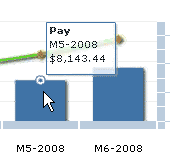

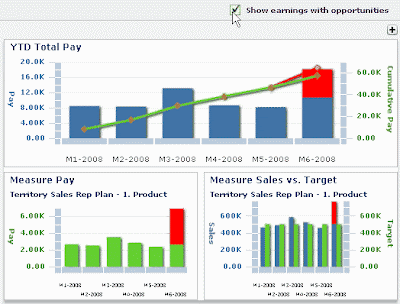
Manager View
The manager view has a very similar look and feel to the salesperson view, but displays information for the entire team:
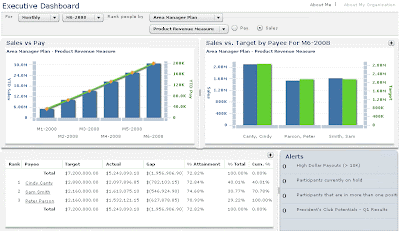
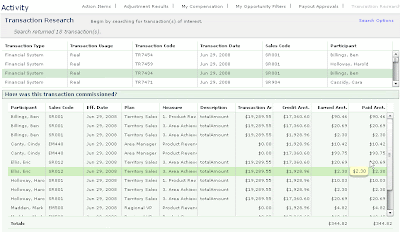
Comp Admin View
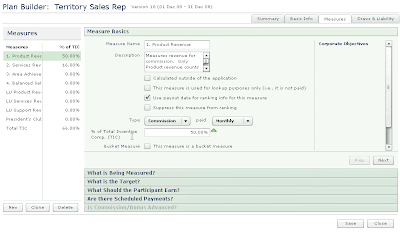 The next step consists in specifying what is being measured, and defining any filters (for example, exclude sales to existing customers):
The next step consists in specifying what is being measured, and defining any filters (for example, exclude sales to existing customers): 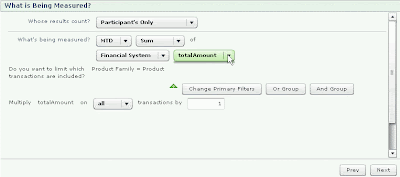
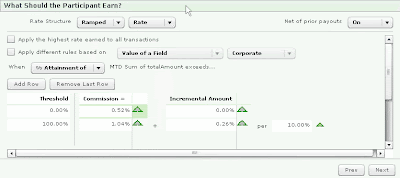
Other systems have a component approach, and maintain a component library. In Compel you build measures. You can clone measures or plans, so if you need to build a new plan it is easy to clone an existing measure and re-use it as is or modify it using the plan builder wizard
Effective Dating:
I described effective dating when reviewing the latest version of Xactly Incent and discussed how critical effective dating is in my opinion. Centive uses effective dating for everything: people records, quotas, measures, plans, transactions, results, reports, etc . which makes its maintenance much easier. It also solves the difficult problem of handling prior period adjustments – Compel recognizes the crediting rules, roll-ups and structures that were in place at the time of the original transaction, and trues-up the adjustment to the current period.
The following plan builder screen capture shows how each plan uses effective dating:
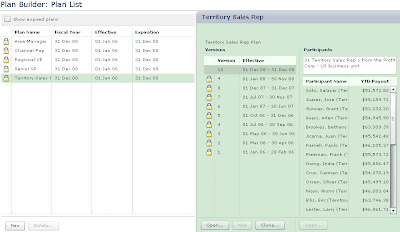
Conclusion
I would probably need to work with Compel to make-up my mind about if I like the concept of how plans are built, since it is so different from the other applications I have seen. It's very exciting to see a different way of thinking.
What I can say is that configuring a plan seems to be a very user-friendly step-by-step task. The user interfaces for sales people and managers are also very clean and display all the required information at a sight. Compel also seems to offer all the functionalities anyone could be looking for, and does so without the need to purchase additional modules.
Sunday, June 8, 2008
The Moral to the ICM Saga
 Read Part 1 and Part 2 of this story first.
Read Part 1 and Part 2 of this story first.The blame cannot be put on one person. ABC Corp, the ICM vendor and the consultant all own some of the responsibility for the issue.
The entire situation could have been avoided if the requirements had been better designed. Requirements could have been better designed if the compensation plans had been completed with enough details. The vendor would probably have done a better job at scoping out the work initially or in certain situations may even have not submitted a proposal.
What can we take away from this story?
- Requirements cannot be fully defined unless the compensation plans are finalized. Requirements may be inaccurate or incomplete unless compensation plans show sufficient details and examples.
- An ICM solution cannot be selected unless the requirements are fully defined.
- Not all ICM solutions can handle very complex compensation plans (no matter what the vendor's rep says). Some solutions are better suited for certain situations.
- Good requirements are the foundation for any IT project, mess up the requirements and the entire project will be shaky.
- Using an experienced consultant to help out with the requirements design, RFP writing and solution selection could be a good idea to select the ideal solution.
- Consultants and vendors alike cannot "always" guess client's intentions.
- Mentioning or emailing a requirement is not enough, this requirement must find its way to the requirement document to ensure it is met by the implementation and properly tested.
Thursday, June 5, 2008
The ICM Saga Continues...
 The vendor finally agrees that because the relationship between their companies is valuable and because of their strong work ethics, they will honor the agreed cost and do everything they can to meet the deadlines.
The vendor finally agrees that because the relationship between their companies is valuable and because of their strong work ethics, they will honor the agreed cost and do everything they can to meet the deadlines.However, problems keep piling up. The ICM solution is not intended to perform what would be required for the compensation plans to work how they are supposed to work. Data integration, workarounds and clever tweaking pushes the ICM solution to its limit. The client is asked to only include what is absolutely necessary in this release and push out the rest. The deadline is missed. The solution is finally implemented, but User Acceptance Testing keeps revealing new issues. The second pay-roll date is approaching but there is still no solution in sight.

Tuesday, June 3, 2008
The Saga of Purchasing an ICM System

Monday, June 2, 2008
Tweak your Sales Compensation Plan - A Tale of Diverging Opinions
 In case you are not familiar with it, the Canadian Professional Sales Association (CPSA) has an excellent magazine called "Contact". The best part is that this magazine is entirely available online, for free, and without any registration. Today I wanted to bring your attention to an article by Jay Somerset called "The Compensation Challenge" which appeared in the Contact Spring 2008 edition.
In case you are not familiar with it, the Canadian Professional Sales Association (CPSA) has an excellent magazine called "Contact". The best part is that this magazine is entirely available online, for free, and without any registration. Today I wanted to bring your attention to an article by Jay Somerset called "The Compensation Challenge" which appeared in the Contact Spring 2008 edition."It may be time to change - or tweak - your sales compensation plan to better compete in today's employee-driven market, but if it is done incorrectly you could send your sales team packing. "
Indeed, tweaking a sales plan is tricky business. Stats mentioned in the article back this up: Less than 10% of North American sales organizations redesign their comp plans in a given year, while the other 90 percent only perform minor tweaks. I think ideally, closer to 100% organizations should only perform minor tweaks. Redesigning a plan could be a sign that it had not been planned out properly, and sometimes organizations are compulsive about trying new plans rather than improving their existing plans by tweaking them.
Diverging Opinions
Greg Blysniuk, president of TopLine Sales Compensation Solutions in Toronto advocates simplicity. He says that sales managers often believe their compensation plans must be sophisticated and complex to compete; Greg believes one or two quantitative measures is all what is required to incent people and to ensure the plans are easy to understand.
David Johnston, president of Sales Resource Group Inc in Oakville, Ontario believes compensation plans should factor in qualitative metrics. "Qualitative metrics can be measured according to milestones or key events".
ICM Applications:
Greg says the main barrier to adopt an ICM application is their cost. He is in favor of using Excel spreadsheets for compensation data collection and analysis. He says that "Spreadsheets are simple to use, inexpensive and they do the basic job".
David does not agree; he says that spreadsheets are "too basic and error-prone". He also says that "sales is much too complex for a spreadsheet". He concludes that there is a middle ground with smaller-scale on-demand ICM applications such as PlanIt (which I reviewed previously), that do not require a large upfront cost.
The Bottom Line:
No matter which approach is used, I'm sure we can all agree that the goal is to make the compensation plans as straightforward as possible. If there is a valid reason for a plan to use some "complex" measurement, fine... as long as it's easy to understand and clearly communicated to the payees.
As for the need for an ICM application; if an organization is small enough with a low enough order volume and is happy with their current spreadsheet, and if they don't see any benefits in real-time analytics and dashboards, auditability, modeling, forecasting, and all the other benefits provided by an ICM solution, then there probably no incentive to replace the spreadsheet by such an application.
I agree with Greg that spreadsheets do the "basic job", but in my experience it does not take very long even for small organizations to realize that the "basic job" is not enough anymore to keep a competitive advantage.
Sunday, June 1, 2008
Last Minute Deal for Enterprise 2.0 Conference
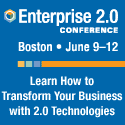 nGenera, is a sponsor of the Enterprise 2.0 conference taking place in Boston between June 9-12, 2008. You can save 100$ from the registration cost by registering here.
nGenera, is a sponsor of the Enterprise 2.0 conference taking place in Boston between June 9-12, 2008. You can save 100$ from the registration cost by registering here.Community.
Let’s learn from each other’s successes and challenges, through networking and stimulating case studies from surprising pioneers.
Education.
Tutorials and sessions led by top minds show you how to make your business more agile, connected and responsive.
Leadership.
Industry visionaries give you a glimpse of the future at the keynote and plenary program.
Solutions.
See the latest technologies from established leaders and hot start-ups in the Demo Pavilion.
Friday, May 30, 2008
Xactly Incent 4.0 - Effective Dating and Other New Features

Enterprise Incentive Management News
Xactly Wins Coveted 2008 CODiE Award
Sales performance management leader takes home software industry's top honor for best financial software solution
XACTLY NAMED TOP FINALIST FOR 2008 AMERICAN BUSINESS AWARDS(SM)
Leading on-demand sales performance management vendor chosen from among 2,600 entries for prestigious Stevie® Awards
Callidus
Sierra Atlantic Partners With Callidus Software to Advance Software-as-a-Service (SaaS) Delivery
Provides Global Delivery Model to Achieve Sales Performance Management Growth
Centive
Centive Named to JMP Securities' Hot 100 Software Companies
"We are pleased to be honored with inclusion in the Hot 100 report by JMPSecurities," said Michael Torto, president and CEO, Centive.
Centive Named as Finalist in 2008 American Business Awards
On-Demand Sales Compensation Management Leader Recognized for Providing Exceptional Customer Service
Tuesday, May 27, 2008
Networking 2.0 - The Art of Making Connections
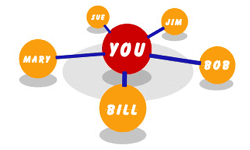 I'm deviating a bit from the incentive, compensation and sales performance management topics to talk about professional networking. I was invited by a Canadian Heritage Network (Generaction) to be a keynote speaker at an event next Thursday (May 29, 2008) in Ottawa. The topic of my presentation is "Networking 2.0 - The Art of Making Connections". You can download my Power Point presentation here.
I'm deviating a bit from the incentive, compensation and sales performance management topics to talk about professional networking. I was invited by a Canadian Heritage Network (Generaction) to be a keynote speaker at an event next Thursday (May 29, 2008) in Ottawa. The topic of my presentation is "Networking 2.0 - The Art of Making Connections". You can download my Power Point presentation here.- Never Eat Alone and Other Secrets to Success One Relationship at a Time by Keith Ferrazzi
- Dig your Well Before You're Thirsty by Harvey Mackay
- Wikinomics: How Mass Collaboration Changes Everything by Don Tapscott
Monday, May 26, 2008
For Love or Money: Social vs Monetary Reward
 Social Status and cash activate the same reward centre in the brain. That's what two papers in the latest Neuron journal (Volume 58, Issue 2) are saying. I'm always very interested by cognitive research attempting to explain how certain activities can affect human behavior.
Social Status and cash activate the same reward centre in the brain. That's what two papers in the latest Neuron journal (Volume 58, Issue 2) are saying. I'm always very interested by cognitive research attempting to explain how certain activities can affect human behavior.The article "Know Your Place: Neural Processing of Social Hierarchy in Humans" by Dr. Caroline Zink and colleagues explains how information about social status activated the same brain regions.
The second article "Processing of Social and Monetary Rewards in the Human Striatum" by Dr. Norihiro Sadato supports how reputation affects people in the same way as money does.
A subscription is required to read those articles, but they were summarized in ABC Science article "Praise or Cash? Your brain doesn't care".
Personal Story:
These studies support my own view on the topic. Last month I discussed the impact of the size of a money bonus on performance. It would be very interesting to see a similar experiment where some a group receive a lot of encouragement and the other group receives no praise at all, to compare their performance.
One of my previous employers, as many employers do, offered an annual performance bonus. This bonus was a percentage of the annual salary, but every employee received a very similar bonus. Employees developed a sense of entitlement to this bonus, and always thought they had met all their performance objectives and deserved the full amount. I'm just giving this context to illustrate how the cash incentive most likely did not have a positive impact on performance.
The employer, aware of this problem, introduced a "praise" program, consisting of recognizing employees who had made a significant contribution. Managers were encouraged to simply give a "Thank You" card to exceptional employees. I have no idea how this program affected performance... But it's impact on motivation was priceless.
Employees receiving these "praises" would shine for weeks. Common sense tells me that motivation can easily be correlated to performance. I can safely say that the thank you notes I received from colleagues I had helped during evenings and weekends really motivated me to keep working hard - there is nothing like feeling appreciated!
Another Story on Social Status
A few weeks ago I read an article about how job titles could be used to motivate employees, even if no pay increase is associated with the new title. I have a friend who had his job title changed from "Business Dev Manager" to "Manager, Entrepreneurship and Innovation Development". He's been jumping up and down since he got this "promotion". His reasons for being so happy: the title is unique, distinguishes him from his peers, and sounds better from his perspective.
Thursday, May 22, 2008
SPM Testing Template - Part 5
Here is an example to get started:
Other benefits of using an Excel spreadsheet to record test results instead of a Word document include:
- Ability to quickly highlight failing tests in red
- Ability to filter information displayed (e.g. display only failing tests)
- Test results can be printed on fewer pages
- Ability to create macros to perform more "fancy" features such as displaying the number of days a certain issue has been opened.
Wednesday, May 21, 2008
PlanIt: Another On-Demand Sales Performance Solution
Sales Resource Group Inc. is an industry leading sales compensation professional services organization that provides world class software, consulting and outsourcing services, with expertise in sales incentive programs and sales force effectiveness.I had heard about their president David Johnston before, from his articles in the Canadian Professional Sales Association (CPSA) Contact magazine. David has over 20 years experience consulting for various organizations and teaches sales compensation for WorldatWork.
What distinguishes Sales Resource Group from many other small sales compensation management companies is that they offer their own sales compensation solution called "PlanIt".
PlanIt is an On-Demand Sales Performance Management solution offering the same functionalities as other applications in its category (incentive calculations, reporting, analytics, etc). In addition, PlanIt also has a module providing guidance to optimize compensation programs and align these programs to business needs, and allows to route relevant documentation to its users.
User Interface
Similar to other applications, PlanIt displays some high level compensation information to the payees when they login. From this screen they can easily review their current revenues, the top 10 performers and their ranking compared to their peers. What I particularly like about the main screen is the News /Announcements which occupies an important position at the top center of the screen. This ensures payees don't miss out on important news.
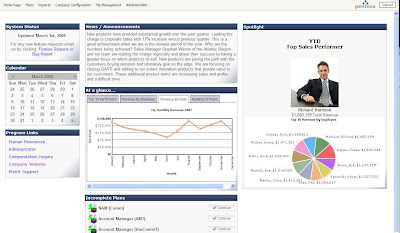
Reporting
The reporting section is also very important for the payees. Most of the reports are available "out-of-the-box" and illustrate all the information in different level of details. Payees can drill down to the order level, or see high level summary of their compensation and ranking. Custom reports can also be created easily.
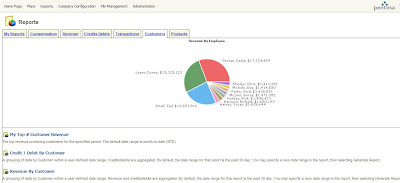
Implementation
Overall the user interface was very nice, but the big question remaining was, how easy is it to implement and maintain solutions built with PlanIt. Not surprisingly the answer was, the implementation is user friendly. It is all done through a user interface and does not require any deep technical skills.
What I particularly liked about the Plan Design interface is its ability have approved plans and plans awaiting approval. I have not seen this functionality in other applications I am familiar with.
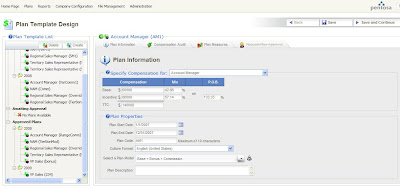 Mobility Feature
Mobility FeatureOnly a week ago I discussed Varicent's mobility feature and I said I hadn't seen this anywhere else; PlanIt is actually available for use on PDA's including Blackberry handsets an Palm devices since April 18th. I haven't seen PlanIt mobile or Varicent mobile, but I wouldn't be surprised if most vendors followed with a similar feature.
Stevie Award for Sales Compensation Program of the Year
In 2006 and 2007, major clients of SRG won the prestigious Stevie Award for Sales Compensation Program of the Year.
Conclusion
In conclusion, I was a bit surprised I hadn't heard about Sales Resource Group before being contacted by Matt. However, with the level of maturity I noticed from their application, I would not be surprised if we started to hear more about them.
Blog Search
Subscribe
Other Resources
Blog Archive
-
▼
2008
(99)
-
►
July
(15)
- Offshoring SPM - Communication Challenges
- Makana Motivator for Free!
- Webinar Galore - 2 SPM Webinars Tomorrow
- Topgrading for Sales Book Review
- New web forum for the EIM Community - Get your Ans...
- SPM Analytics Webinar Tomorrow, 1PM Central
- Offshore Outsourcing - Humor of the Week
- Compensation Architect: The New Blog on the Block
- Offshoring Sales Performance Management Implementa...
- Incentive Compensation Industry News
- Popularity Burst
- Upcoming Sales Performance Analytics Webinar, July...
- ICM Implementation Offshoring Pros and Cons
- Outsourcing and Offshoring your SPM Implementation
- Six Disciplines Execution Revolution Book Review
-
►
June
(13)
- SPM News - Big News for Callidus, Varicent and Ope...
- Don’t Automate Chaos
- Sales Performance Management Glossary
- Stick to a Naming Convention - It's not Rocket Sci...
- Incentive Compensation News
- Incentive Compensation Meets HR at The Super Sexy ...
- EIM Solution Maintainability - Should you care abo...
- Review of Centive Compel On-Demand EIM Solution
- The Moral to the ICM Saga
- The ICM Saga Continues...
- The Saga of Purchasing an ICM System
- Tweak your Sales Compensation Plan - A Tale of Div...
- Last Minute Deal for Enterprise 2.0 Conference
-
►
July
(15)
Tags
- Sales Performance Management (34)
- Incentive Compensation (27)
- Callidus (19)
- Xactly (17)
- Industry News (15)
- SaaS (15)
- Sales Compensation (14)
- Incentive Strategy (12)
- On-demand (11)
- Best Practices (10)
- Centive (9)
- Case Study (8)
- Webinar (8)
- Varicent Software (7)
- Applications (6)
- Compensation Plans (6)
- ICM (6)
- Incentive Compensation Management (6)
- Pros and Cons (6)
- David Cichelli (5)
- IT offshoring (5)
- News (5)
- Technical Tips (5)
- Testing (5)
- Accenture (4)
- Enterprise Incentive Management (4)
- Implementation (4)
- OpenSymmetry (4)
- RFP (4)
- Return on Investment (4)
- Synygy (4)
- Variable Compensation (4)
- outsourcing (4)
- Analytics (3)
- Ask the Expert (3)
- Consultant (3)
- Funny (3)
- Humor (3)
- IT outsourcing (3)
- Information (3)
- Makana (3)
- Performance Measurement (3)
- Procurement (3)
- Research (3)
- SalesForce.com (3)
- nGenera (3)
- Banking (2)
- Bonus (2)
- Compel (2)
- Excel (2)
- Gartner (2)
- Greg Livengood (2)
- Ice-breaker (2)
- Implementation Partner (2)
- Incentive Plans (2)
- Merced Systems (2)
- Offshore (2)
- On-premise (2)
- Opinions (2)
- Personal Story (2)
- Practique Associates (2)
- Review (2)
- SPM (2)
- Sales Resource Group (2)
- SuccessFactors (2)
- Template (2)
- "Canadian Professional Sales Association" (1)
- "Dig your Well before you're Thirsty" (1)
- "Don Tapscott" (1)
- "Effective Dating" (1)
- "Harvey Mackay" (1)
- "Incent 4.0" (1)
- "Jay Somerset" (1)
- "Keith Ferrazzi" (1)
- "Never Eat Alone" (1)
- AskJon (1)
- BSG Alliance (1)
- Benefits (1)
- Blog (1)
- Book Review (1)
- Boutique Consulting (1)
- Bradford Smart (1)
- Business Process Reengineering (1)
- CPSA (1)
- Challenges (1)
- Coaching (1)
- Compensation Architect (1)
- Competency Management (1)
- Configuration Management (1)
- Consulting (1)
- Contests (1)
- Cygnal Group (1)
- Dashboard (1)
- Deployment Checklist (1)
- Donya Rose (1)
- EIM Software (1)
- Effective Dating (1)
- Enterprise 2.0 (1)
- Eran Carmel (1)
- ForceLogix (1)
- Gary Harpst (1)
- Global Workforce (1)
- Glossary (1)
- Go-live (1)
- Greg Alexander (1)
- HCM (1)
- HR Carnival (1)
- ICM Solution (1)
- Iconixx (1)
- In-house Development (1)
- Incentive Compensation Glossary (1)
- Insurance (1)
- Integration (1)
- Interviewing (1)
- Jeff Kaplan (1)
- Job (1)
- Job Evaluation (1)
- Jon Ingham (1)
- Jon Walheim (1)
- Julien Dionne (1)
- KPI (1)
- Leapcomp (1)
- Livengood Consulting Group (1)
- Maintainability (1)
- Management (1)
- Methodology (1)
- Metrics (1)
- Migration (1)
- Motivator (1)
- Naming Convention (1)
- Networking (1)
- Offshore Communication Challenges (1)
- Offshoring Information Technology (1)
- Optimization (1)
- Oracle (1)
- PPM (1)
- Paul Tjia (1)
- Pervasive Performance Management (1)
- Plan Design (1)
- PlanIt (1)
- Prediction (1)
- Press Release (1)
- Professional Networking (1)
- R (1)
- Reporting (1)
- SPM Question (1)
- Sales Performance Management Outsourcing (1)
- Santorini Consulting (1)
- Six Disciplines Execution Revolution (1)
- Spiff (1)
- Sungard (1)
- THINKStrategies (1)
- Talent (1)
- Terminology (1)
- TextPad (1)
- Topgrading for Sales (1)
- Towers Perrin (1)
- TrueTarget (1)
- Truecomp (1)
- Tutorial (1)
- Vendor (1)
- Ventana Research (1)
- Version Control (1)
- Visa (1)
- Wikinomics (1)
- competitive advantage (1)
- sales rep (1)
About Me

- Julien Dionne
- Ottawa, Ontario, Canada
- Julien Dionne is a well-rounded consultant with global business management experience and outstanding technical, business and leadership skills. He earned a Bachelor of Applied Science in Software Engineering from the University of Ottawa, Canada, and he is a member of the Canadian Professional Sales Association. The views posted within this blog do not reflect the views of Julien’s current or previous employers and clients. Julien can be reached at julien.dionne@gmail.com











